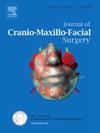Feasibility of the preauricular transparotid approach in open reduction and internal fixation of intracapsular mandibular condyle fracture
IF 2.1
2区 医学
Q2 DENTISTRY, ORAL SURGERY & MEDICINE
引用次数: 0
Abstract
Mandibular condyle fractures pose surgical challenges owing to their proximity to the facial nerve and the complex temporomandibular joint anatomy. Traditional approaches limit exposure and hinder effective fracture management. The preauricular transparotid approach is a potential alternative. We aimed to assess the feasibility of this approach and the postoperative complications.
A retrospective analysis of 45 patients who underwent open reduction/internal fixation (OR/IF) for intracapsular condylar fractures using a preauricular transparotid approach was conducted. Patient demographics, surgical procedures, radiological assessments, and postoperative complications were analyzed.
The preoperative computed tomography analysis revealed the fractured segment's location: 17.0 ± 2.6 mm anteriorly, 24.0 ± 4.0 mm medially, and 17.8 ± 3.7 mm inferiorly from the remaining condyle end. A cubic space of 17–24 mm from the condylar stump is necessary to reach the fractured segment end. Postoperative facial nerve weakness occurred in 14 patients but resolved within 4.5 weeks. At 5.5 months of follow-up, the mean interincisional mouth opening measured 40.5 ± 5.1 mm, without malocclusion.
The approach enhances visualization, facilitates precise fixation, and results in inconspicuous scarring during OR/IF of intracapsular condylar fractures. It requires careful surgical techniques and increases the risk of transient facial nerve weakness. Further research should compare its outcomes with those of traditional approaches and optimize surgical outcomes.
下颌骨髁状突骨折由于靠近面神经和复杂的颞下颌关节解剖结构,给手术带来了挑战。传统的方法限制了暴露,妨碍了骨折的有效处理。耳前经颈动脉入路是一种潜在的替代方法。我们旨在评估这种方法的可行性和术后并发症。我们对使用耳前经齿状突入路对髁突内骨折进行切开复位/内固定术(OR/IF)的 45 位患者进行了回顾性分析。研究分析了患者的人口统计学特征、手术过程、放射学评估和术后并发症。术前计算机断层扫描分析显示骨折段的位置为前方 17.0 ± 2.6 毫米,内侧 24.0 ± 4.0 毫米,距剩余髁端下方 17.8 ± 3.7 毫米。从髁突残端到骨折段末端需要17-24毫米的立方空间。14 名患者术后出现面神经无力,但在 4.5 周内缓解。在 5.5 个月的随访中,切口间的平均张口度为 40.5 ± 5.1 毫米,没有出现错颌畸形。在髁突内骨折的手术/内固定过程中,该方法可增强可视性,便于精确固定,并可留下不明显的疤痕。该方法需要谨慎的手术技巧,并增加了一过性面神经无力的风险。进一步的研究应将其结果与传统方法进行比较,并优化手术结果。
本文章由计算机程序翻译,如有差异,请以英文原文为准。
求助全文
约1分钟内获得全文
求助全文
来源期刊
CiteScore
5.20
自引率
22.60%
发文量
117
审稿时长
70 days
期刊介绍:
The Journal of Cranio-Maxillofacial Surgery publishes articles covering all aspects of surgery of the head, face and jaw. Specific topics covered recently have included:
• Distraction osteogenesis
• Synthetic bone substitutes
• Fibroblast growth factors
• Fetal wound healing
• Skull base surgery
• Computer-assisted surgery
• Vascularized bone grafts

 求助内容:
求助内容: 应助结果提醒方式:
应助结果提醒方式:


